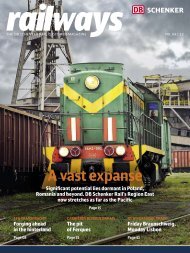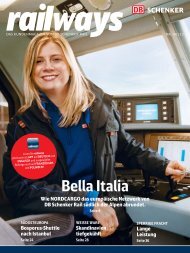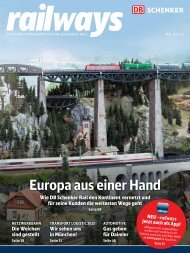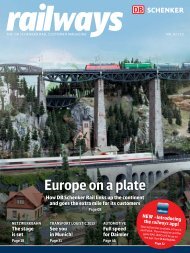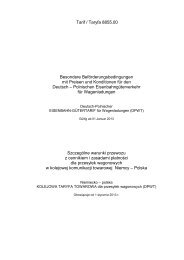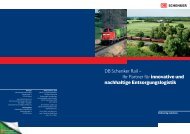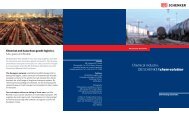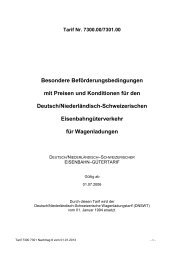EUROPE - DB Schenker Rail
EUROPE - DB Schenker Rail
EUROPE - DB Schenker Rail
You also want an ePaper? Increase the reach of your titles
YUMPU automatically turns print PDFs into web optimized ePapers that Google loves.
<strong>EUROPE</strong><br />
INNOVATION:<br />
If freight trains can<br />
operate at double the<br />
current approved<br />
length of 740 metres,<br />
the freight capacity<br />
of existing main lines<br />
could be substantially<br />
increased.<br />
20 | <strong>Rail</strong>ways<br />
Freight train times two<br />
Many main lines in Central Europe are already operating at full stretch.<br />
More freight per train could increase this capacity.<br />
<strong>DB</strong> is therefore planning a feasibility study into much longer trains.<br />
Germany’s rail infrastructure is currently designed<br />
for trains with a total length of up to<br />
740 metres. Longer trains could boost the efficiency<br />
and productivity of rail freight transport,<br />
significantly increasing the volumes transported on<br />
main lines that are already operating at full capacity.<br />
This would help to improve the competitiveness of<br />
rail freight transport on a more permanent basis,<br />
while effectively countering the capacity-boosting<br />
measures of competing carriers (e.g. gigaliner trucks).<br />
Longer freight trains are soon set to become a reality<br />
in transport operations between Germany and<br />
Denmark. According to the proposal, freight trains<br />
operating from the German-Danish border crossing<br />
at Padborg to the Maschen marshalling yard south of<br />
Hamburg will be extended to 835 metres long – as is<br />
already customary in Denmark.<br />
In the long term, however, Deutsche Bahn AG is<br />
thinking of other dimensions: “We are specifically<br />
focusing on doubling the current maximum permissible<br />
train length to 1,500 metres because we expect<br />
to achieve the greatest boost in efficiency from the<br />
joining together of two conventional freight<br />
trains,” explains Jürgen Kandt, Project Manager<br />
of the “Longer Freight Trains” concept<br />
at <strong>DB</strong> <strong>Schenker</strong> <strong>Rail</strong>. “These trains<br />
could then be used on key main<br />
lines which would then be ap- proved<br />
for longer freight trains, being coupled<br />
together ac- cording to the<br />
feeder train con- cept, for example,<br />
a n d t h e n separated again at the<br />
end.”<br />
Throughout all the preliminary<br />
research into the feasibility of<br />
the “freight train times two” concept, <strong>DB</strong><br />
<strong>Schenker</strong> <strong>Rail</strong> has been working very closely with<br />
<strong>DB</strong> Netz AG and <strong>DB</strong>’s technology department<br />
because longer freight trains need comparable<br />
running and braking characteristics to the<br />
current trains, suitable operating concepts<br />
and the right infrastructure. Togeth- e r<br />
with the Federal Ministry for Econom- ic Affairs,<br />
a study of the topic within a public<br />
research programme is currently b e i n g<br />
prepared. “We are not expecting the implementation<br />
of this concept in the short<br />
term owing to the numer- ous challenges<br />
involved,” says Dr Miro- slav Obrenovic,<br />
Head of Innovation Management at <strong>DB</strong><br />
<strong>Schenker</strong> <strong>Rail</strong>. “But for us the 1,500-metrelong<br />
freight train is a key innovation topic.”<br />
ok<br />
Contact | Miroslav Obrenovic<br />
Tel. +49 (0)6131 15-62400<br />
miroslav.obrenovic@dbschenker.eu<br />
Contact | Jürgen Kandt<br />
Tel. +49 (0)6131 15-60265<br />
juergen.kandt@dbschenker.eu




